In an astounding achievement, Bhutan tiger numbers grow by 27%
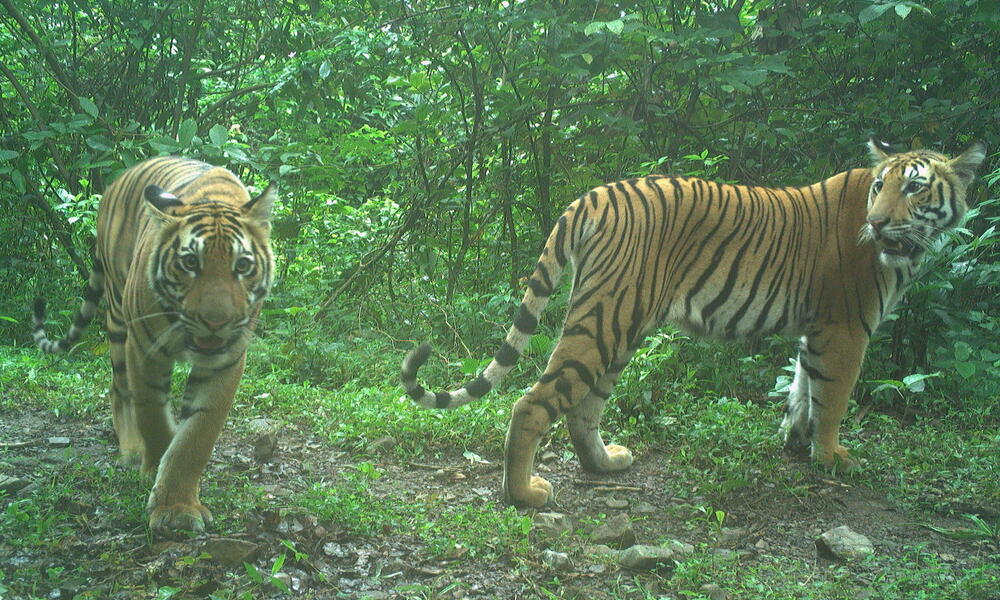
© DoFPS
DATE: July 29, 2023
AUTHOR :Alison Henry
As a result of a longstanding and steadfast commitment to conservation, Bhutan has increased the number of tigers within its borders by 27% since 2015—an astounding achievement. There are now an estimated 131 tigers in this eastern Himalayan country, according to the most recent survey conducted in 2021 and 2022.
A collective effort among the Royal Government of Bhutan, local partners, and non-governmental organizations such as WWF-Bhutan serve as the foundation for this success. The Bhutan Tiger Center led efforts to monitor and research the country’s tiger population and worked with local communities to radio-collar tigers to study their movements and conduct surveys.
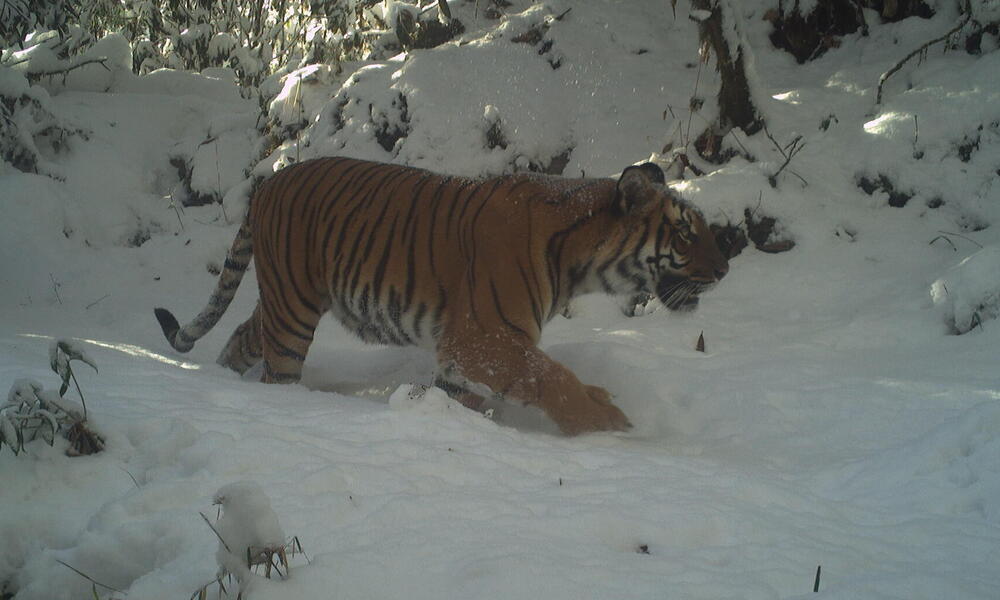
DATE: July 29, 2023
AUTHOR :Alison Henry
As a result of a longstanding and steadfast commitment to conservation, Bhutan has increased the number of tigers within its borders by 27% since 2015—an astounding achievement. There are now an estimated 131 tigers in this eastern Himalayan country, according to the most recent survey conducted in 2021 and 2022.
A collective effort among the Royal Government of Bhutan, local partners, and non-governmental organizations such as WWF-Bhutan serve as the foundation for this success. The Bhutan Tiger Center led efforts to monitor and research the country’s tiger population and worked with local communities to radio-collar tigers to study their movements and conduct surveys.

© DoFPS
A tiger recorded on a camera trap in Bhutan during the 2021-2022 national tiger survey.
A tiger recorded on a camera trap in Bhutan during the 2021-2022 national tiger survey.
“Bhutan's conservation efforts continue to inspire hope for the recovery of many threatened species. The recent news of increasing tiger numbers in Bhutan serves as a clear testament to what can be achieved when nations and their people demonstrate selfless dedication to conservation for the good of humanity and the planet.”Dechen DorjiSenior Director, Asian Wildlife
A fruitful journey
Bhutan’s journey to achieving the tiger numbers we see today began more than a decade ago when the country joined a global effort to double the number of tigers in the wild by 2022. This effort went hand-in-hand with Bhutan’s promise to preserve over half of its land under forest cover—a decision that ties cultural connection with nature.
In the years since, Bhutan has implemented a suite of strategies to increase wild tiger populations, from adopting a global conservation tool that sets best practices and standards to manage wild tiger sites to equipping rangers with improved monitoring and reporting technology to make them more effective in stopping wildlife crime. And a cross-border tiger conservation program with India in the Transboundary Manas Conservation Area (TRAMCA) proved so successful that data from the most recent survey conducted in 2018 estimates that these big cats doubled in number on both sides of the political border since 2010.
The 2021-2022 national tiger survey also unlocked new insights into the growing population of tigers in the country. Regions not previously known to have tigers reported sightings, and breeding tigers were recorded at high elevations, supporting the popular theory that Bhutan is a source site for tigers in the region.
Tiger conservation starts with community partnership
Local communities are essential to protecting wild tigers. Like in many places, when human populations and demand for space grow, people and wildlife are increasingly interacting and competing for resources, which can lead to increased human-wildlife conflict. But despite tigers killing a high number of livestock in Bhutan, retaliatory killings of these big cats have been very low. This tolerance is derived, in part, from the value and compassion Buddhism encourages towards nature. Still, the situation is complex, and WWF-Bhutan has been working with communities in the Trongsa District—an area of northeast Bhutan that lies within Jigme Singye Wangchuck National Park—to address the damage human-tiger conflict has on livelihoods.
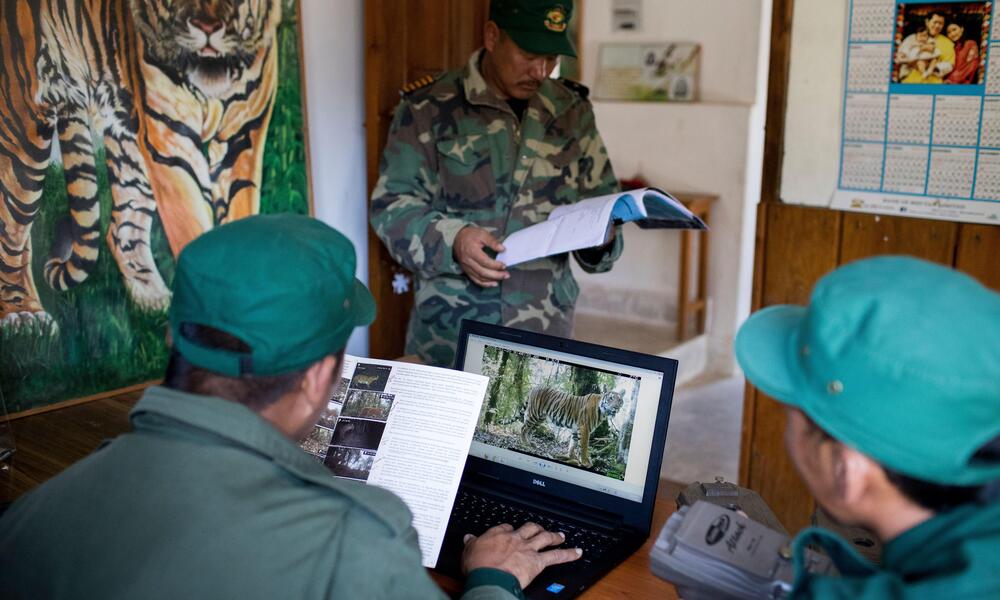
© Emmanuel Rondeau / WWF-UK
Government rangers at Jigme Singye Wangchuck National Park head office study images of tigers captured by camera traps in the area.
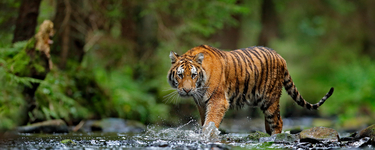
Government rangers at Jigme Singye Wangchuck National Park head office study images of tigers captured by camera traps in the area.

Shutterstock / Ondrej Prosicky / WWF-Sweden
CELEBRATE GLOBAL TIGER DAY!
You can protect wildlife and nature worldwide today.
SYMBOLICALLY ADOPT A TIGER

CELEBRATE GLOBAL TIGER DAY!
You can protect wildlife and nature worldwide today.
SYMBOLICALLY ADOPT A TIGER

© Tashi Phuntsho / WWF-Bhutan
WWF-Bhutan carried out surveys across Trongsa District, capturing thoughts from a number of different community voices.
A recent survey of 610 households in the region showed that most of the communities’ livelihoods depend on livestock and many people felt concerned about an increase in tigers in the area because of the socio-economic impact. Sharing space with big cats also took a psychological toll, according to the survey. And though WWF-Bhutan has yet to conduct similar research across the country, it’s likely that other communities facing increased human-tiger conflict feel the same.
WWF-Bhutan has been a long-time supporter of work in the Trongsa District, focusing on how better protected area management can improve livelihoods and safeguard both people and tigers. In 2022, Bhutan’s government worked with local communities in Trongsa to establish six Gewog (sub district) Tiger Conservation Tshogpa (committee)—community-led tiger conservation groups that encourage stewardship of tigers, manage human-tiger conflict, and provide livestock insurance. They’re located in human-tiger conflict hotspots and include four communities in Trongsa. WWF-Bhutan is helping create an additional conservation group in Trongsa and will provide financial support to its members and help build capacity to sustain and succeed. In addition, we will be working with local communities in Trongsa to better understand their tolerance for living alongside tigers and implement a holistic conflict management system that will work toward human-tiger coexistence.
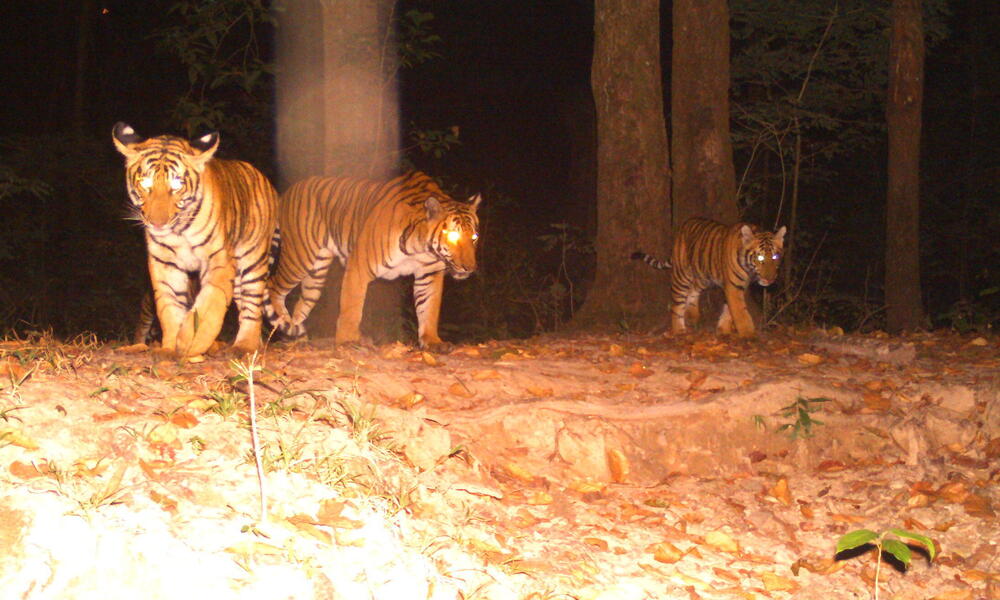
WWF-Bhutan carried out surveys across Trongsa District, capturing thoughts from a number of different community voices.
A recent survey of 610 households in the region showed that most of the communities’ livelihoods depend on livestock and many people felt concerned about an increase in tigers in the area because of the socio-economic impact. Sharing space with big cats also took a psychological toll, according to the survey. And though WWF-Bhutan has yet to conduct similar research across the country, it’s likely that other communities facing increased human-tiger conflict feel the same.
WWF-Bhutan has been a long-time supporter of work in the Trongsa District, focusing on how better protected area management can improve livelihoods and safeguard both people and tigers. In 2022, Bhutan’s government worked with local communities in Trongsa to establish six Gewog (sub district) Tiger Conservation Tshogpa (committee)—community-led tiger conservation groups that encourage stewardship of tigers, manage human-tiger conflict, and provide livestock insurance. They’re located in human-tiger conflict hotspots and include four communities in Trongsa. WWF-Bhutan is helping create an additional conservation group in Trongsa and will provide financial support to its members and help build capacity to sustain and succeed. In addition, we will be working with local communities in Trongsa to better understand their tolerance for living alongside tigers and implement a holistic conflict management system that will work toward human-tiger coexistence.

© DoFP
Tigers recorded on camera trap in Bhutan during the 2021-2022 national tiger survey.
A bright future for people and tigers
Bhutan has shown that with government support, the right conservation interventions, a robust ranger workforce, and community partnerships, tiger populations can recover—and even flourish. While the national tiger survey tallied many big cats, it also took a snapshot of the abundance of wildlife that lives alongside the iconic big cat, proving that when we protect tigers, we protect so much more.
WWF congratulates Bhutan on its success in increasing the country’s tiger population while recognizing that even in the diverse and vast forests of this amazing country, tiger conservation progress is fragile. Bhutan is evidence of why we need robust and measurable goals focusing on living with tigers to ensure a promising future for these iconic big cats and people alike.
Tigers recorded on camera trap in Bhutan during the 2021-2022 national tiger survey.
A bright future for people and tigers
Bhutan has shown that with government support, the right conservation interventions, a robust ranger workforce, and community partnerships, tiger populations can recover—and even flourish. While the national tiger survey tallied many big cats, it also took a snapshot of the abundance of wildlife that lives alongside the iconic big cat, proving that when we protect tigers, we protect so much more.
WWF congratulates Bhutan on its success in increasing the country’s tiger population while recognizing that even in the diverse and vast forests of this amazing country, tiger conservation progress is fragile. Bhutan is evidence of why we need robust and measurable goals focusing on living with tigers to ensure a promising future for these iconic big cats and people alike.
No comments:
Post a Comment